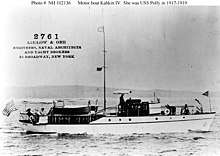USS Polly (SP-690)
USS Polly (SP-690) was a United States Navy patrol vessel in commission from 1917 to 1919. After the conclusion of her Navy career, she operated in the fleet of the United States Bureau of Fisheries as USFS Curlew.
.jpg) USS Polly (SP-690) during World War I. | |
| History | |
|---|---|
| Name: |
|
| Owner: | Private owners |
| Builder: | New York Yacht, Launch and Engineering Company, Morris Heights, the Bronx, New York |
| Completed: | 1909 |
| Fate: | Sold to U.S. Navy 14 May 1917 |
| History | |
| Name: | USS Polly |
| Namesake: | Previous name retained |
| Acquired: | 14 May 1917 |
| Commissioned: | 15 May 1917 |
| Stricken: | 11 March 1919 |
| Fate: | Transferred to U.S. Bureau of Fisheries 9 September 1919 |
| History | |
| Name: | USFS Curlew |
| Namesake: | Curlew, a bird of the genus Numenius characterized by a long, slender, down-curved bill and mottled brown plumage |
| Acquired: | 9 September 1919 |
| Identification: |
|
| Notes: | Retired 1937–1938 |
| General characteristics (as U.S. Navy vessel) | |
| Type: | Patrol vessel |
| Tonnage: | 28 gross register tons |
| Length: | 61 ft 9 in (18.82 m) |
| Beam: | 11 ft (3.4 m) |
| Draft: | 3 ft (0.91 m) |
| Speed: | 17 knots |
| Complement: | 10 |
| Armament: |
|
Construction and early history

Polly was built as the private motorboat Howmornel by the New York Yacht, Launch and Engineering Company at Morris Heights in the Bronx, New York, in 1909. She later was renamed Kakhin IV and Polly.
U.S. Navy
On 14 May 1917, the U.S. Navy purchased Polly from William H. Merriman, of New Haven, Connecticut, for use as a section patrol boat during World War I. She was commissioned at Newport, Rhode Island, as USS Polly (SP-690) on 15 May 1917 with Chief Quartermaster H. L. Wakeman, USNRF, in command.
Assigned to the 2nd Naval District in southern New England, Polly carried out patrol duties for the rest of World War I.
Polly was stricken from the Navy List on 11 March 1919 and transferred to the United States Bureau of Fisheries on 9 September 1919.[2]
U.S. Bureau of Fisheries
The U.S. Bureau of Fisheries (BOF) renamed the vessel USFS Curlew, and, after modifying her for fisheries duty, assigned her to the BOF station at Cape Vincent, New York, for use in fish-culture work on Lake Ontario.[3]
During the summer of 1922, the Cape Vincent station installed electric lighting aboard Curlew and attached metal plates to the forward part of her hull at the waterline to protect her planking.[4] On 24 September 1923, Curlew rescued 58 passengers from the Canadian steamboat Waubic, which had run aground in fog at Bear Point about 8 nautical miles (15 km; 9.2 mi) from Cape Vincent while making her daily run between Cape Vincent and Kingston, Ontario, Canada.[5] During fiscal year 1928, which ran from 1 July 1927 to 30 June 1928, Curlew underwent extensive repairs and alterations and her original engine was replaced by a diesel engine.[6]
United States Department of Commerce records list Curlew as being in the Bureau of Fisheries fleet as of 30 June 1937[7] but not as of 30 June 1938,[8] indicating that the Bureau retired her sometime during fiscal year 1938 (1 July 1937–30 June 1938).
References
- U.S. Department of Commerce Bureau of Navigation and Steamboat Inspection, Merchant Vessels of the United States (Including Yachts and Government Vessels), Year Ended June 30, 1933, Washington, D.C.: United States Government Printing Office, 1932, pp. 151, 1131.
- Bureau of Fisheries, Report of the United States Commissioner of Fisheries for the Fiscal Year 1919 With Appendixes, Washington, D.C.: Government Printing Office, 1919, p. 55.
- Bureau of Fisheries, Report of the United States Commissioner of Fisheries for the Fiscal Year 1921 With Appendixes, Washington, D.C.: Government Printing Office, 1922, p. 49.
- Bureau of Fisheries, Propagation and Distribution of Food Fishes, Fiscal Year 1923, Washington, D.C.: Government Printing Office, 1924, p. 45.
- Anonymous, "Steamer Waubic Goes Aground," Cape Vincent Eagle, September 27, 1923, unpaginated
- Bureau of Fisheries, Propagation and Distribution of Food Fishes, Fiscal Year 1928, Washington, D.C.: Government Printing Office, 1929, p. 369.
- U.S. Department of Commerce Bureau of Marine Inspection and Navigation, Merchant Vessels of the United States (Including Yachts and Government Vessels), Year Ended June 30, 1937, Washington, D.C.: Government Printing Office, 1937, p. 619.
- U.S. Department of Commerce Bureau of Marine Inspection and Navigation, Merchant Vessels of the United States (Including Yachts and Government Vessels), Year Ended June 30, 1938, Washington, D.C.: United States Government Printing Office, 1938, p. 531.
- This article incorporates text from the public domain Dictionary of American Naval Fighting Ships. The entry can be found here.
- Department of the Navy Naval History and Heritage Command Online Library of Selected Images: U.S. Navy Ships: USS Polly (SP-690), 1917-1919. Originally the civilian motor boat Howmornel, Kahkin IV and Polly.
- NavSource Online: Section Patrol Craft Photo Archive Polly (SP 690)